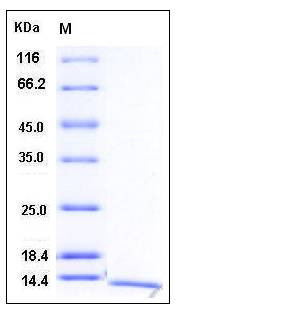Human S100A16 / S100F Protein
AAG13,DT1P1A7,MGC17528,S100F
- 100ug (NPP4231) Please inquiry
| Catalog Number | P11137-HNAE |
|---|---|
| Organism Species | Human |
| Host | E. coli |
| Synonyms | AAG13,DT1P1A7,MGC17528,S100F |
| Molecular Weight | The recombinant human S100A16 comprises 103 amino acids and has a predicted molecular mass of 11.9 kDa. It migrates as a 13 kDa band in SDS-PAGE under reducing conditions. |
| predicted N | Met 1 |
| SDS-PAGE |  |
| Purity | > 92 % as determined by SDS-PAGE |
| Protein Construction | A DNA sequence encoding the human S100A16 (Q96FQ6) (Met 1-Ser 103) was expressed and purified. |
| Bio-activity | |
| Research Area | Cancer |Signal transduction |Calcium-binding Proteins and Related Molecules |
| Formulation | Lyophilized from sterile 50mM Tris, pH 8.0 1. Normally 5 % - 8 % trehalose and mannitol are added as protectants before lyophilization. Specific concentrations are included in the hardcopy of COA. |
| Background | S100A16 is a member of S100 protein super family that carries calcium-binding EF-hand motifs. S100 proteins are cell- and tissue-specific and are involved in many intra- and extracellular processes through interacting with specific target proteins. S100A16 expression was found to be astrocyte-specific. The S100A16 protein was found to accumulate within nucleoli and to translocate to the cytoplasm in response to Ca(2+) stimulation. The homodimeric structure of human S100A16 in the apo state has been obtained both in the solid state and in solution, resulting in good agreement between the structures with the exception of two loop regions. The homodimeric solution structure of human S100A16 was also calculated in the calcium(II)-bound form. Differently from most S100 proteins, the conformational rearrangement upon calcium binding is minor. Immunoprecipitation analysis revealed that S100A16 could physically interact with tumor suppressor protein p53, also a known inhibitor of adipogenesis. Overexpression or RNA interference-initiated reduction of S100A16 led to the inhibition or activation of the expression of p53-responsive genes, respectively. S100A16 protein is a novel adipogenesis-promoting factor. |
| Reference |
